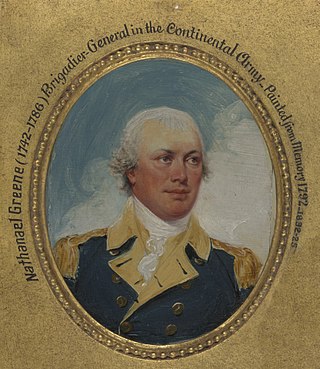
Major-General Nathanael Greene was an American military officer and planter who served in the Continental Army during the Revolutionary War. He emerged from the war with a reputation as one of George Washington's most talented and dependable officers and is known for his successful command in the Southern theater of the conflict.

The Springfield Armory, more formally known as the United States Armory and Arsenal at Springfield located in the city of Springfield, Massachusetts, was the primary center for the manufacture of United States military firearms from 1777 until its closing in 1968. It was the first federal armory and one of the first factories in the United States dedicated to the manufacture of weapons. The site is preserved as the Springfield Armory National Historic Site, Western Massachusetts' only unit of the national park system. It features the world's largest collection of historic American firearms.

James Mitchell Varnum was an American legislator, lawyer, general in the Continental Army, and a pioneer to the Ohio Country.
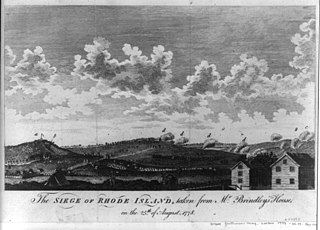
The Battle of Rhode Island took place on August 29, 1778. Continental Army and Militia forces under the command of Major General John Sullivan had been besieging the British forces in Newport, Rhode Island, which is situated on Aquidneck Island, but they had finally abandoned their siege and were withdrawing to the northern part of the island. The British forces then sortied, supported by recently arrived Royal Navy ships, and they attacked the retreating Americans. The battle ended inconclusively, but the Continental forces withdrew to the mainland and left Aquidneck Island in British hands.

The Newport Artillery Company of Newport, Rhode Island was chartered in 1741 by the Rhode Island General Assembly during the reign of King George II of Great Britain. It is the oldest military unit in the United States operating under its original charter, and the company maintains a museum in its historic armory. The company has served in wars ranging from the French and Indian War to the First World War. Individual members of the Company have served in every war fought by the United States.
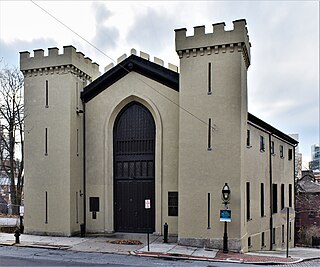
The State Arsenal, originally the Providence Marine Corps of Artillery Arsenal, and commonly called the Benefit Street Arsenal is a historic armory building located at 176 Benefit Street in the College Hill neighborhood of Providence, Rhode Island. It was built in 1839, was designed by Russell Warren in the Gothic Revival style, and was built by Tallman & Bucklin.

The Colonel Micah Whitmarsh House is an historic house in East Greenwich, Rhode Island. The 2+1⁄2-story Greek Revival style brick house was built c. 1767-1771 by John Reynolds, and acquired in 1773 by Micah Whitmarsh, a founding member of the local Kentish Guards militia, which are located nearby in the Armory of the Kentish Guards. It is distinctive as the only brick house on Main Street. It has been owned since 1966 by the East Greenwich Historical Society.

The Warwick Civic Center Historic District is a historic district encompassing three buildings at the civic heart of Warwick, Rhode Island.

The Broadway–Armory Historic District is a historic district encompassing a mainly residential mixed-used urban area west of downtown Providence, Rhode Island.
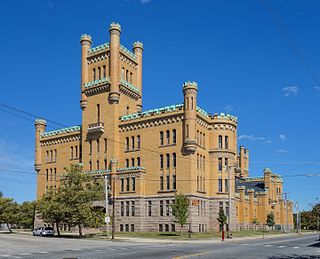
The Cranston Street Armory is an historic building in the Broadway–Armory Historic District of Providence, Rhode Island. It was built in 1907 at a cost of $650,000.00. The building was occupied by the Rhode Island National Guard from its opening until 1996. Since then, parts of the building have been used as film studios, and some of its offices occupied by the Rhode Island State Fire Marshal. The National Trust for Historic Preservation listed the Armory as one of "America's 11 Most Endangered Historic Places" in its annual list for 1997. Its distinctive yellow bricks, crenellated turrets, and decorative stonework mark it as a historically significant building and neighborhood icon.

The Rhode Island Army National Guard (RIARNG) is the land force militia for the U.S. state of Rhode Island. It operates under Title 10 and Title 32 of the United States Code and operates under the command of the state governor while not in federal service. National Guard units may function under arms in a state status, therefore they may be called up for active duty by the governor to help respond to domestic emergencies and disasters, such as those caused by hurricanes, floods, or civil unrest.
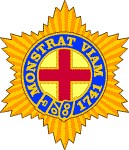
The First Corps of Cadets of Massachusetts formed in 1741. Its motto is Monstrat Viam - "It Points the Way." While it has served in several wars, the sub-unit's primary contribution to Massachusetts and to the United States was as an officer-producing institution for new regiments from the Revolutionary War through World War II.

Major General Nathanael Greene is a bronze equestrian statue honoring Nathanael Greene, a military leader during the American Revolutionary War. Greene was from modern-day Rhode Island and after laws passed by the Kingdom of Great Britain, along with the burning of one of his ships, Greene formed a state militia. He was later promoted to brigadier general in the Continental Army where he became a trusted adviser to Commander-in-Chief General George Washington. Greene played an active role during the war, participating in battles, sieges, and campaigns from New England to the Southern Colonies. For his service to the war, Greene was offered free land and settled in Georgia with his family. He died a few years later from a heatstroke.

The 103rd Field Artillery Regiment is a regiment of the United States Army. The only currently existing component is the 1st Battalion, 103rd Field Artillery Regiment, a unit of the Rhode Island National Guard. The regiment was originally constituted in 1917, but it descends from predecessor units dating back to 1801.

The Rhode Island State Guard is the currently inactive state defense force of Rhode Island. As a state defense force, the Rhode Island State Guard served as a state military unit which assumed the stateside duties of the Rhode Island National Guard when the National Guard was in federal service. However, unlike the National Guard, the State Guard, when organized, answers solely to the Governor of Rhode Island and by law cannot be federalized or deployed outside the borders of Rhode Island.
The 243rd Coast Artillery Regiment was a Coast Artillery Corps regiment in the Rhode Island National Guard. It garrisoned the Harbor Defenses of Narragansett Bay, Rhode Island 1924–1944.

The Rhode Island Independent Military Organizations are a group of independently operated chartered militias in the state of Rhode Island, most of whose histories date back to the state's colonial and revolutionary history. Under Rhode Island law, they are considered part of state's organized militia forces but are explicitly distinct from Rhode Island's National Guard, State Guard, and Naval Militia. Today, these organizations are largely ceremonial and educational in purpose but are sometime called up for active civil service in minor capacities.

Gloucester Light Infantry is an active independent military organization of the Rhode Island militia that was founded in 1774 and currently serves primarily as a ceremonial honor guard and educational group. The Gloucester Light Infantry operates an armory museum behind the town hall at 33 Dorr Drive in Chepachet, Rhode Island which was the former ell of the Chepachet Elementary School.

The Varnum Continentals are an active independent military organization of the Rhode Island militia that was founded in 1903 and currently serve primarily as a ceremonial honor guard and as historic educational organization in East Greenwich, Rhode Island. The Warren Varnum Continentals operate the historic Varnum Memorial Armory, an armory museum at 6 Main Street in East Greenwich, which was built in 1913, and housed Rhode Island State and National Guard units from 1918 to 1996. The Varnum Continentals were named after Revolutionary War General James Mitchell Varnum, a founder of the Kentish Guards, and the Continentals are dedicated to preserving Varnum's memory.

The Kentish Artillery was a military organization in Rhode Island originating in the 18th century.






















